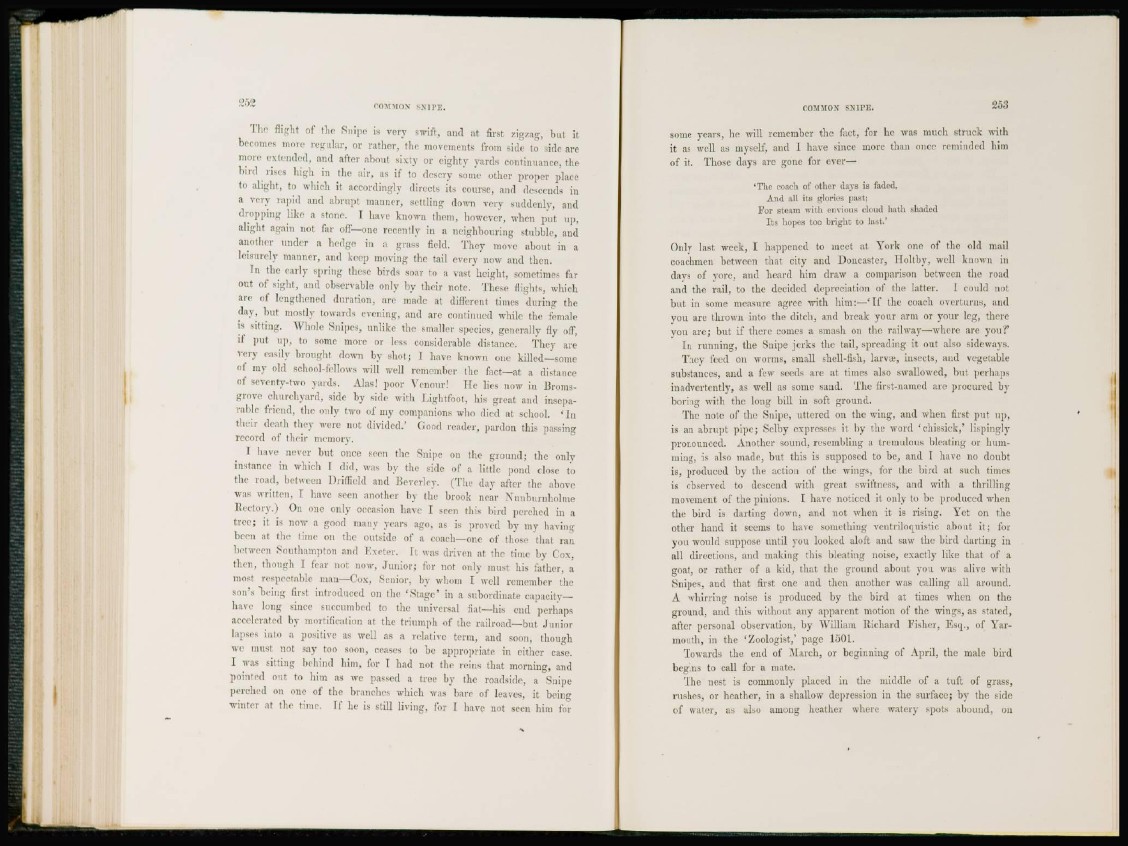
252 COMMON SNIPE.
The flight of the Snipe is very swift, and at first zigzag, but it
becomes more regular, or rather, the movements from side to side are
more extended, and after about sixty or eighty yards continuance, the
bird rises high in the air, as if to descry some other proper place
to alight, to which it accordingly directs its course, and descends in
a very rapid and abrupt manner, settling down very suddenly, and
dropping like a stone. I have known them, however, when put u p ,
alight again not far off—one recently in a neighbouring stubble, and
another under a hedge in a grass field. They move about in a
leisurely manner, and keoj) moving the tail every now and then.
In the early spring these birds soar to a vast height, sometimes far
out of sight, and observable only by their note. These flights, which
are of lengthened duration, are made at different times during the
day, hut mostly towards evening, and are continued while the female
is sitting. Whole Snipes, unlike the smaller species, generally fly off,
if put Up, to some more or less considerable distance. They are
very easily brought down by shot; I have known one killed—some
of my old school-fellows will well remember the fact—at a distance
of seventy-two yards, Alas! poor Venour! He lies now in Bromsgrove
churchyard, side by side with Lightfoot, his great and inseparable
friend, the only two of my companions who died at school. ' In
their death they were not divided.' Good reader, pardon this passing
record of their memory.
I have neTer but once seen the Snipe on the ground; the only
instance in which I did, was by the side of a. little pond close to
the road, between Driffield and Beverley. (The day after the above
was written, 1 have seen another by the brook near Nunhurnholnie
Rectory.) On one only occasion have I seen this bird perched in a
t r e e ; it is now a. good many years ago, as is proved by my having
been at the time on the outside of a coach—one of those that ran
between Southampton and Exeter, It was driven at the time by Cox,
then, though I fear not now, J u n i o r ; for not only must his father, a
most respectable man—Cox, Senior, by whom I well remember the
son's "being first introduced on the ' S t a g e ' in a subordinate capacity—
have long since succumbed to the universal fiat—his end perhaps
accelerated by mortification at the triumph of the railroad—but Junior
lapses into a positive as well as a relative term, and soon, though
we must not say too soon, ceases to be appropriate in either case.
I was sitting behind him, for I had not the reins that morning, and
pointed out to him as we passed a tree by the roadside, a Snipe
perched on one of the branches which was bare of leaves, it being
winter at the time. If he is still living, for 1 have not seen him for
COMMON SNIPE. £63
some years, he will remember the fact, for he was much struck with
it as well as myself, and I have since more than once reminded him
of it. Those days are gone for ever—
"The coach of other days is faded,
And all its glories past;
For steam with envious cloud hath shaded
Its hopes too bright to lust.'
Onlv last week, I happened to meet at York one of the old mail
coachmen between that city and Doncastcr, Holtby, well known in
days of yore, and heard him draw a comparison between the road
and the rail, to the decided depreciation of the latter. I could not
but in some measure agree with him:—'If the coach overturns, and
you are thrown into the ditch, and break your arm or your leg, there
von arc; but if there comes a smash on the railway—where are you?'
In running, the Snipe jerks the tail, spreading it out also sideways.
They feed on worms, small shell-fish, larva?, insects, and vegetable
substances, and a few seeds are at times also swallowed, but perhaps
inadvertently, as well as some sand. The first-named are procured bv
boring with the long bill in soft ground.
The note of the Snipe, uttered on the wing, and when first put u p ,
is an abrupt pipe; Selby expresses it by the word 'chissick,* lispingly
pronounced. Another sound, resembling a tremulous bleating or humming,
is also made, but this is supposed to be, and I have no doubt
is, produced by the action of the wings, for the bird at such times
is observed to descend with great swiftness, and with a thrilling
movement of the pinions. I have noticed it only to be produced when
the bird is darting down, and not when it is rising. Yet on the
other hand it seems to have something vent riloquis tic about it; for
you would suppose until you looked aloft and saw the bird darting in
all directions, and making this bleating noise, exactly like that of a
goat, or rather of a kid, that the ground about you was alive with
Snipes, and that first one and then another was calling all around.
A whirring noise is produced by the bird at times when on the
ground, and this without any apparent motion of the wings, as stated,
after personal observation, by William Richard Fisher, Esq., of Yarmouth,
in the 'Zoologist,1 page 1501.
Towards the end of March, or beginning of April, the male bird
begins to call for a mate.
The nest is commonly placed in the middle of a tuft of grass,
rushes, or heather, in a shallow depression in the surface; by the side
of water, as also among heather where watery spots abound, on